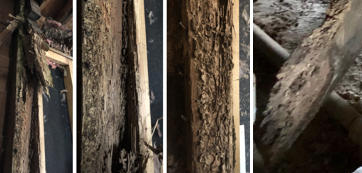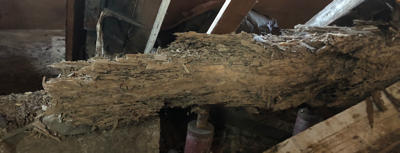Subject: 112 year old farmhouse - Termite damage
Date: Tuesday, 7 Jan 2020
Hi,
I just purchased a 112 year old farmhouse to restore & unfortunately it is very chewed up by termites. So any recommendations are much appreciated.
Thank you,
Jennifer
Jennifer,
While there can be some rot associated with insect damage, it is more often the case that you are dealing with just the insect damage alone. As such, you typically use less of a good penetrating epoxy like the CPES, or S-1 Sealer, and more of the filling products. Which filler you use depends on whether the insect damage is external or internal.
External insect damage is usually fairly straightforward. Internal insect damage is slightly more troublesome. First off, you need to determine the extent of the damage. Secondly you need to get the products where they need to go. Termites especially will chew the softer parts of the wood, leaving layers of cavity and wood. These layers can be horizontal or vertical, depending on how the wood is oriented. If you drill a hole on one side of the wood, you might get only one chamber, while if you drill 90 degrees to that, you would get most or all the chambers.
Once you have drilled enough holes to get to all the damage, you want to wet out the inside of the damaged areas with the S-1 Sealer. If you have rot as well, that needs to be soaked to saturation. After several hours, it is important to mop out, or drain out any excessive puddling of the S-1 Sealer. Depending on how much S-1 Sealer is soaked in, the wood will need to be left to dry for anywhere from a few days to a few weeks, shorter being more common.
Once the S-1 Sealer is well on its way to being fully cured, the fillers can be used. With internal cavities, a more liquid fill is the most useful. For this, I usually use the General Purpose Epoxy Resin, in whatever temperature formula is appropriate at the time of application. As with any two part epoxy, you want to be careful of mixing and pouring larger batches. With larger cavities, it is advisable to fill in stages, letting the previous pour/fill harden.
If the area is not contained, a thicker filler is needed. The Sculpwood Epoxy Paste is more generally useful, especially with some sawdust on hand to thicken it if that is desired or needed. The Sculpwood Epoxy Putty is quite thick, and can do larger fills, especially if a sag resistant product is needed.
In summary, S-1 Sealer, GP Resin, Sculpwood Paste, sawdust, and Sculpwood Putty are the products that I would want or need for the type of work you seem to have. Quantities can be harder to judge. We would be happy to help with this. If you wanted our help, sending us images of the damage could be useful.
Doc


Jennifer,
Thanks for the detailed images. I would categorize what I am seeing as severe termite damage. It is possible to restore significant structural strength to even the most deteriorated wood. However, there are a couple of things to consider.
First, it can be expensive. While it is often more cost effective to repair than replace, at a certain point, that changes. At that stage, I would only recommend repair if the wood has significant historical value.
Second, while significant structural strength can be restored, it is difficult to determine exactly how much strength has been restored, unless you test it to failure. Which defeats the purpose.
Third, if the structure needs to be inspected and permitted, inspectors are usually hesitant to sign off on uncertain repairs.
At this point, I have a pretty good idea of what you are dealing with. I would like to talk in more detail over the phone about what your options are. Often we find that a hybrid repair can be the best route. Some replacement, some repair, as is best warranted.
Doc